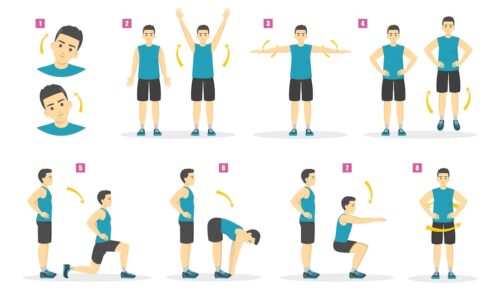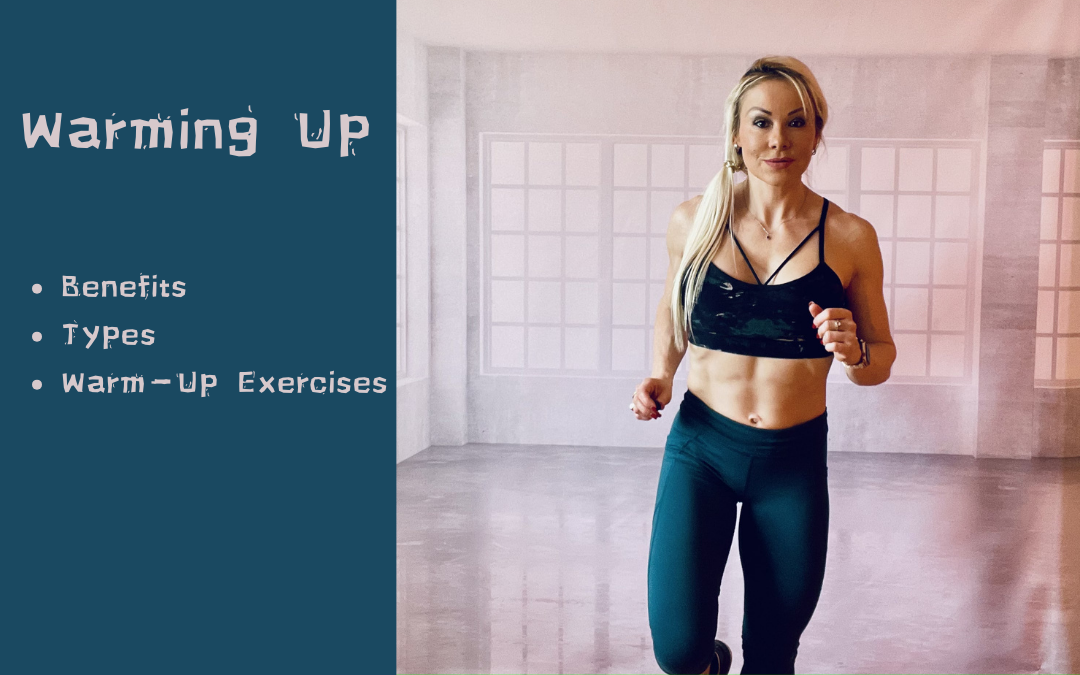You know how important exercise is, not only for the body but for the mind. But do you know that warming up is almost as important? Warming up is a crucial component of any physical activity since it prepares your body and mind for a workout, sports practice, or any other form of exercise. Read on to learn all the benefits of warming up and ways to warm up.
Benefits of Warming Up
Research shows that “warming up prior to exercise is vital for the attainment of optimum performance.” It brings “temperature, metabolic, neural and psychology-related effects.” Let’s look into some additional benefits of warming up and later we’ll delve into ways to warm up.
Enhanced Blood Flow
Warming up causes vasodilation which increases blood flow to your muscles. This prepares your muscles for the upcoming activity since there is an increased removal of waste products and delivery of oxygen and nutrients into the tissues.
Increased Muscle Temperature
Another benefit of warming up is the increase in muscle temperature, which improves muscle elasticity and metabolic reactions. This raised temperature facilitates faster nerve impulses and muscle contractions, leading to enhanced performance.
Improved Flexibility
Adding dynamic stretching to your warm-up routine can help improve flexibility. As a result, your movements become more efficient and you reduce your risk of strains and sprains.
Enhanced Post-Activation Potentiation (PAP)
PAP is where the force-generating capacity of a muscle is temporarily enhanced following a high-intensity activity or warm-up. This occurs due to changes in the physiological and mechanical properties of muscles. Warming up enhances PAP.
Neural Activation
Warming up activates the central nervous system, leading to improved coordination, motor unit recruitment, and synchronization of muscle fibers. This heightened neural drive primes the muscles for greater force production during subsequent activity.
Elevated Oxygen Uptake Kinetics
Warm-ups activate the aerobic energy system, which relies heavily on oxygen to produce energy. The body increases blood flow which carries more oxygen to the muscles and enhances their ability to generate energy aerobically. Then, muscle temperature increases, which improves oxygen extraction from the blood and leads to more efficient oxygen utilization by muscle cells.
Improved Metabolic Rate
By increasing blood flow and body temperature, warming up activates various metabolic pathways within your body that help provide energy for exercise and can lead to a higher metabolic rate – a higher amount of energy expended over time.
Enhanced Calorie Burn
Since warming up increases the metabolic rate during and after exercise, your body burns more calories and continues to burn at a higher rate even after you’ve finished working out.
Improved Anaerobic Metabolism
Anaerobic metabolism refers to energy production without oxygen. During a warm-up, muscles start to metabolize glucose anaerobically to produce energy. Anaerobic metabolism helps activate muscles, making them more responsive and ready for intense activity. It also leads to the production of lactate, which at high rates leads to lactate buildup and consequently fatigue and muscle soreness, but during the warm-up, the body can better clear lactate due to increased blood flow and oxygen delivery to muscles. Warming up doesn’t necessarily enhance anaerobic metabolism but prepares the body for more vigorous activity.
Decreased Delayed Onset Muscle Soreness (DOMS)
Decreased Delayed Onset Muscle Soreness (DOMS) or post-workout pain takes place when you train pretty hard or your muscles are not adequately prepared for the stress of exercise. Warming up helps you avoid DOSM even though you can deal with DOMS with certain techniques.
Improved Range of Motion
Since warming up helps increase blood flow to the muscles, they become ready for exercise. This prevents you from having stiff muscles that have a limited range of motion.
Enhanced Muscle Performance
Cold muscles are less flexible and responsive, which can impair your performance. By warming up, you gradually increase your heart rate and optimize your body system (as described above), which primes your muscles for better performance. This can lead to improved strength, power, and endurance during your workout or activity.
Minimized Risk of Injury
When you warm up, you prepare your muscles, tendons, and ligaments for the demands of exercise. This minimizes your risk of strains, sprains, and other injuries. Additionally, you can even avoid putting unnecessary strain on your cardiovascular system – this could take place when you are not sufficiently fit and suddenly increase your heart rate and blood pressure through intense exercise.
Augmented Psychological Preparedness
Another very important benefit of warming up is its impact on your psychological state. This habit plays a role in preparing you mentally for the upcoming physical activity, helping focus your attention, reduce anxiety, build confidence, and get into the right mindset – all of which positively impact performance.
Ways to Warm Up Before Working Out
Types of Warm-Ups
Now that you know all the benefits of warming up, let’s look into the different types of warm-ups. Passive and active warm-ups are both techniques used to prepare the body for physical activity, but they differ in their approach and execution.
Passive Warm-Up:
One way to warm up is doing a passive warm-up. This raises the body temperature and prepares the muscles for activity without having to be physically active. Some examples of passive warm-up techniques include hot showers, sauna sessions, hot packs, or even simply wearing warm clothing to increase body temperature.
- Benefits: Passive warm-ups can help increase blood flow to muscles, improve flexibility, and decrease the risk of injury by loosening up stiff joints and muscles. It also increases body temperature without depleting energy stores.
- Suitability: Passive warm-ups are suitable for any individual, even those with limited mobility or those recovering from injury since they do not require active movement.
Active Warm-Up:
Another way to warm up is by doing an active warm-up. This involves performing light to moderate physical exercises or movements that gradually increase heart rate, blood flow, and body temperature. Some examples of active warm-up techniques include dynamic stretches, jogging, jumping jacks, arm circles, leg swings, or any low-intensity aerobic activities.
- Benefits: Active warm-ups not only increase body temperature and blood flow but also prepare the muscles, tendons, and joints for the specific movements involved in the upcoming activity. They can improve flexibility, coordination, and overall athletic performance. This type of warm-up induces greater metabolic changes, leading to increased preparedness for a subsequent exercise task.
- Suitability: Active warm-ups are generally suitable for most individuals engaging in physical activity, as they help mimic the movements and demands of the activity they’re preparing for.
Active warm-up is generally considered more effective in preparing the body for physical activity as it not only increases body temperature but also enhances muscle activation, flexibility, and coordination. It may also be more effective in reducing the risk of injury since it specifically targets the muscles and movements involved in the upcoming activity. You can combine passive and active warm-up techniques or practice the one that is more suitable for your condition, activity type, or specific goals.
Active Warm-Up Ideas

The benefits of warming up are numerous and ways to warm up are diverse too. The following are some specific ways to warm up effectively:
If you are going to engage in a strengthening routine or moderate-intensity activity (such as brisk walking or riding a bike on level ground), here are some ways to warm up:
- March in place
- Arm Swings
- Torso Rotations
- Arm Circles
- Single-Leg Balance Reach
- Single-Leg Deadlifts (no weights)
If you are going to engage in vigorous physical activity, such as swimming, running, playing a sport, power-lifting, or other strenuous physical movements, you’ll need a dynamic warm-up. Here are some other ways to warm up:
- Sport Movements: Repeatedly practice the moves that you are going to perform later. First slowly and gradually with more intensity
- Light Cardio: Do the elliptical, the bike, or jog for 5 to 10 minutes
- Leg Swings (front and back and/or side to side)
- Air Punches: Punch the air in front of you, alternating right and left arms several times. You can do cross-body punches, uppercuts (punching upward), spinning back fists, superman punches, etc.
- Jumping Lunges
- Walking Knee Hugs
- Walking Kicks
- Squat Jumps
- Walking Lunges
- Shuffle
- Jumping Jacks
- Butt Kicks
- High Knees
- Squad to Calf Raises
- Plyometrics
- Carioca
- Skater Jumps
- Zig Zag Hops
- Step-ups
- Backward Jog
- Star Jumps
Active Warm-Up Tips
As mentioned above, active warm-ups are highly effective. Just make sure to implement the following tips:
- Incorporate dynamic movements
- Include some light cardiovascular exercises
- Perform dynamic stretches, which involve continuous movement and focus on major muscle groups, rather than static stretches
- Make sure to gradually increase the intensity of your warm-up to match the intensity of your workout to fully engage the muscles and nervous system
- Pay attention to how your body feels
These tips can ensure that you appropriately prepare your body for the demands of your workout and further potentiate muscle performance.
Warm-Up Video
Not warming up before physical activity can have various consequences on the body, depending on the intensity and duration of the activity. Now that you know all the amazing benefits of warming up and ways to warm up, you can incorporate a proper warm-up routine into your exercise regimen. Warming up is essential since it helps you prevent injuries, improve performance, get the most out of your workouts, and promote overall health and well-being.
To a Fitter Healthier You,
The Fitness Wellness Mentor



